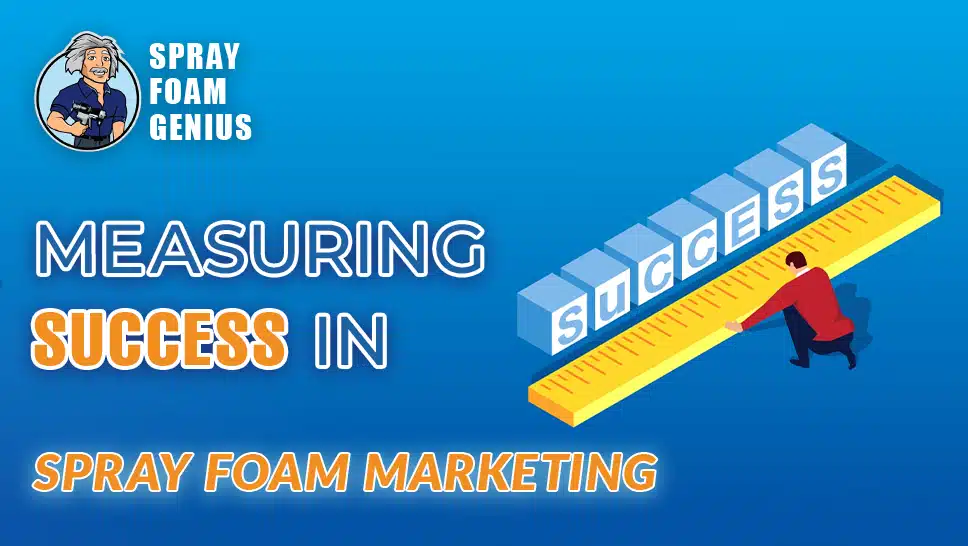
When it comes to spray foam insulation marketing, understanding how to measure success is essential for optimizing your strategy and ensuring business growth. At Spray Foam Genius Marketing, we specialize in delivering tailored marketing solutions exclusively for spray foam insulation contractors. In this comprehensive guide, we’ll explore the key metrics and methods for evaluating the effectiveness of your marketing campaigns, offering actionable insights to enhance your efforts.
Why Measuring Success is Crucial
Measuring the success of your marketing initiatives is more than just tracking metrics—it’s about understanding how these efforts impact your business’s growth and profitability. For spray foam insulation contractors, effective measurement can mean the difference between a thriving business and one struggling to attract and convert leads. By evaluating your marketing performance, you can make informed decisions, optimize strategies, and achieve better results.
Key Metrics to Track
To effectively measure the success of your marketing efforts, focus on these key metrics:
1. Website Traffic
Why It Matters: Website traffic is a fundamental indicator of how well your online presence is performing. An increase in traffic usually reflects successful marketing activities and improved visibility. For spray foam insulation contractors, high traffic levels can lead to more potential leads and increased brand awareness.
How to Measure: Utilize tools like Google Analytics to track:
- Total Visits: The overall number of times users visit your site.
- Unique Visitors: The count of distinct individuals visiting your site.
- Source of Traffic: Insights into whether visitors come from organic search, paid ads, social media, or referrals.
How to Improve:
- SEO Optimization: Enhance your website’s content and structure to rank higher in search engine results.
- Content Marketing: Publish valuable and relevant content to attract more visitors.
- Advertising: Invest in targeted ads to drive traffic to your site.
2. Conversion Rate
Why It Matters: Conversion rate measures how effectively your website turns visitors into leads or customers. For spray foam insulation contractors, a high conversion rate means that your website and marketing messages are compelling enough to persuade visitors to take action, such as requesting a quote or contacting you.
How to Measure: Calculate conversion rate using the formula: Conversion Rate=Number of ConversionsTotal Visitors×100\text{Conversion Rate} = \frac{\text{Number of Conversions}}{\text{Total Visitors}} \times 100Conversion Rate=Total VisitorsNumber of Conversions×100
How to Improve:
- Optimize Landing Pages: Ensure that landing pages are user-friendly and contain clear calls-to-action (CTAs).
- A/B Testing: Experiment with different versions of your web pages to determine which elements drive the highest conversions.
- Simplify Forms: Make it easy for visitors to contact you or request a quote by simplifying your forms.
3. Cost Per Lead (CPL)
Why It Matters: Cost Per Lead (CPL) measures the cost-effectiveness of your lead generation efforts. For spray foam insulation contractors, understanding CPL helps in managing your marketing budget more efficiently and ensuring that you get the best return on your investment.
How to Measure: Calculate CPL with the formula: CPL=Total Marketing CostsNumber of Leads\text{CPL} = \frac{\text{Total Marketing Costs}}{\text{Number of Leads}}CPL=Number of LeadsTotal Marketing Costs
How to Improve:
- Refine Targeting: Use detailed targeting in your ads to reach the most relevant audience.
- Improve Ad Copy: Craft compelling ad copy to attract high-quality leads.
- Monitor and Adjust: Regularly review your marketing spend and adjust strategies based on performance data.
4. Return on Investment (ROI)
Why It Matters: ROI is a crucial metric that measures the profitability of your marketing campaigns. For spray foam insulation contractors, a positive ROI indicates that your marketing efforts are generating more revenue than they cost.
How to Measure: Calculate ROI using the formula: ROI=Net Profit from MarketingMarketing Costs×100\text{ROI} = \frac{\text{Net Profit from Marketing}}{\text{Marketing Costs}} \times 100 ROI=Marketing CostsNet Profit from Marketing×100
How to Improve:
- Focus on High-Performing Channels: Invest more in channels that deliver the best ROI.
- Optimize Campaigns: Continuously refine your marketing strategies to enhance effectiveness.
- Track Expenses: Keep a detailed record of all marketing costs to ensure accurate ROI calculations.
5. Customer Lifetime Value (CLV)
Why It Matters: Customer Lifetime Value (CLV) measures the total revenue you can expect from a customer over the duration of their relationship with your business. Understanding CLV helps you assess the long-term profitability of your customer base and justify marketing expenditures.
How to Measure: Calculate CLV using the formula: CLV=Average Purchase Value×Number of Transactions×Average Customer Lifespan\text{CLV} = \text{Average Purchase Value} \times \text{Number of Transactions} \times \text{Average Customer Lifespan}CLV=Average Purchase Value×Number of Transactions×Average Customer Lifespan
How to Improve:
- Enhance Customer Retention: Implement loyalty programs and exceptional customer service to keep clients returning.
- Upsell and Cross-Sell: Offer additional services or products to increase the value of each customer.
- Build Relationships: Focus on building strong relationships with clients to encourage repeat business.
Tools and Techniques for Measurement

1. Google Analytics
Google Analytics is a powerful tool for tracking and analyzing website performance. It provides insights into user behavior, traffic sources, and conversion metrics, helping you understand the effectiveness of your marketing efforts.
Features to Use:
- Behavior Flow: Visualize how users navigate through your site.
- Goals: Set up goals to track specific actions, such as form submissions or phone calls.
- Ecommerce Tracking: Monitor revenue and transaction data if applicable.
2. Google Search Console
Google Search Console helps you monitor and improve your website’s search performance. It provides data on keyword rankings, click-through rates (CTR), and indexing issues, allowing you to optimize your SEO strategy.
Features to Use:
- Performance Report: Analyze search traffic and keyword performance.
- Coverage Report: Identify and fix indexing issues.
- Sitemap Submission: Ensure that search engines can crawl your site efficiently.
3. CRM Systems
Customer Relationship Management (CRM) systems are essential for tracking interactions with leads and customers. They help manage customer data, track communication history, and analyze lead sources.
Features to Use:
- Lead Tracking: Monitor the progress of leads through the sales funnel.
- Customer Segmentation: Segment customers based on demographics or behavior for targeted marketing.
- Sales Analytics: Analyze sales data to identify trends and opportunities.
4. Social Media Analytics
Social media analytics tools provide insights into the performance of your social media marketing efforts. They help you track engagement metrics and evaluate the effectiveness of your social media campaigns.
Features to Use:
- Engagement Metrics: Monitor likes, shares, comments, and follower growth.
- Audience Insights: Understand your audience demographics and interests.
- Campaign Performance: Evaluate the success of specific social media campaigns.
5. Marketing Automation Tools
Marketing automation tools streamline your lead generation and nurturing processes. They provide data on email open rates, click-through rates, and campaign performance, helping you optimize your email marketing strategies.
Features to Use:
- Email Analytics: Track the performance of your email campaigns.
- Lead Scoring: Assess the quality of leads based on engagement and behavior.
- Campaign Reports: Generate reports to analyze the effectiveness of marketing automation efforts.
Analyzing and Interpreting Data
Collecting data is just the beginning. To effectively measure success, you need to analyze and interpret the data to make informed decisions.
1. Identify Trends
Look for patterns and trends in your data to understand what’s working and what’s not. For example, if you notice an increase in traffic from a specific source, it may indicate a successful marketing channel.
2. Compare Against Benchmarks
Compare your metrics against industry benchmarks or historical data to assess your performance. This comparison helps you set realistic goals and identify areas for improvement.
3. Segment Data
Segment your data by various factors such as demographics, traffic sources, or campaign types. This segmentation allows for a more detailed analysis and helps you understand which segments are performing well.
4. Make Data-Driven Decisions
Use your insights to make informed decisions about your marketing strategies. Adjust your approach based on the data to improve performance and achieve better results.
Common Pitfalls and How to Avoid Them
1. Relying on Vanity Metrics
Vanity metrics like total website visits may look impressive but don’t always reflect meaningful success. Focus on metrics that directly impact your business goals, such as conversion rates and ROI.
How to Avoid:
- Prioritize metrics that align with your business objectives.
- Avoid making decisions based solely on superficial data.
2. Ignoring Data Quality
Ensuring the accuracy and reliability of your data is crucial. Incorrect or incomplete data can lead to misguided decisions.
How to Avoid:
- Regularly audit your data sources and measurement tools.
- Verify data accuracy before making significant changes.
3. Neglecting Customer Feedback
Customer feedback provides valuable insights into the effectiveness of your marketing. Ignoring feedback can result in missed opportunities for improvement.
How to Avoid:
- Collect and analyze customer feedback regularly.
- Use feedback to make improvements to your marketing strategies.
Boost your business performance today!
Measuring success in spray foam insulation marketing involves tracking a range of metrics to gain a comprehensive understanding of your marketing effectiveness. By focusing on website traffic, conversion rates, cost per lead, return on investment, and customer lifetime value, you can make data-driven decisions to optimize your marketing strategy.
At Spray Foam Genius Marketing, we are dedicated to helping spray foam insulation contractors like you succeed in a competitive market. Our expertise in SEO, Google My Business optimization, local SEO, and more can help you achieve your marketing goals.
Ready to enhance your marketing strategy? Call us at 877-840-FOAM for USA and 844-741-FOAM for Canada visit our website at sprayfoamgeniusmarketing.com, or email us at [email protected] to get started.
Let’s work together to measure and maximize your success!
- 5 Google My Business Hacks to Double Your Leads for Spray Foam Insulation Contractors - January 14, 2025
- Why Spray Foam Contractors Cannot Ignore Reputation Management in 2025 - January 13, 2025
- Local SEO Secrets Every Spray Foam Contractor Must Know to Win in 2025 - January 13, 2025

